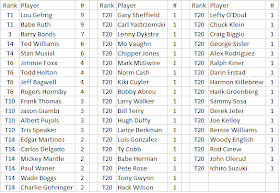That was the subject of a recent
Wall Street Journal article by economist Andrew Zimbalist titled
The Yankees Didn't Buy the World Series. On the surface, it would seem that they did. They ususally have the highest payroll and they signed three big free agents in the off season, 1B man Mark Teixeira and pitchers C. C. Sabathia & A. J. Burnett. Teixeira led the American League in home runs and runs batted in while the two pitchers both finished in the top 20 in earned run average and the top 11 in innings pitched.
But Zimbalist said:
"It's a little surprising, but the statistical relationship between a team's winning percentage and its payroll is not very high. When I plot payroll and win percentage on the same graph, the two variables don't always move together. In other words, knowing a team's payroll does not enable one to know a team's win percentage.
More precisely, depending on the year, I find somewhere between 15% and 30% of the variance in team win percentage can be explained by the variance in team payroll. That means between 70% and 85% of a team's on-field success is explained by factors other than payroll. Those factors can include front office smarts, good team chemistry, player health, effective drafting and player development, intelligent trades, a manager's in-game decision-making, luck, and more."
Some readers, however, disagreed, making some good points in the letters to the editor a few days later (see
In Baseball’s World Series, Money Loads the Bases). The best point may have been made by Ira H. Malis who mentioned that the top 4 teams in salaries in the American League make up, on average, 60% of the teams that make the playoffs.
Economist T. Norman Van Cott makes a good point in support of Zimbalist, that long before the period of free agency, when players can sell their services to the highest bidder (with certain limits), the Yankees dominated baseball. But we need to recall that before 1965, a player coming out of high school or college could sign a contract with any team (but then the reserve clause kept them tied to that team forever). The Yankees had money advantage over the other teams in getting good players in the first place. They could offer bigger bonuses and the promise of often getting a World Series check and making business connections in New York.
Zimbalist also only analyzed the salary and win relationship one year at a time. I did something different last year, using team averages over many years. I found a stronger relationship between salaries and wins that Zimbalist did, that almost 50% of variance in team win percentage can be explained by the variance in team payroll Here is that post (
Another look at salaries and wins).
Alot of people have looked at this. But I started thinking about it again after I came across some data at JC Bradbury's site. You can view that data
here. The data shows how many games, on average, that teams won each year from 1986-2005. It also shows how much above or below the league average in total salary each team paid in percentage terms. Again, it shows yearly averages. Suppose a team was 10% above average one year and 30% above average another year, they would get 20 (if were just over two years).
What I did was to run a regression with average wins per year as the dependent variable and the average salary (SAL, the % above or below the league average) as the independent variable.
Here is the regression equation
Wins = 0.157*SAL + 80.22
The r-squared was .489 and the standard error was 3.89 wins. The T-value for SAL was 5.17. The .157 means that if you spent 10% more on salaries than the average team, you win 1.57 more games than the average team. A zero for SAL would mean that a team spent the average amount on salaries. A negative number means the team spent below the average salary level. The table below summarizes each team.

Tampa Bay, for example, on average, had a payroll that was 38.87% below the league average. They were predicted to win 74.12 but only 64.33 wins per game. If a team were to spend 100% more than average, it should win about 96-97 games a year. The Yankees had the highest payroll above average. They spent about 70% more than the average team. They were predicted to win 91.26 games a year but actually only won 90.24.
I think the results are fairly strong. 16 of the 30 teams were predicted to within 3 or fewer wins. Only 3 were off by 6 or more wins. I think what I did differently than JC Bradbury was to use the average annual values for each team, instead of each team's data for each year. By using the averages, I think the randomness from year-to-year is eliminated. A team can sign a big free agent and maybe one year he does not do well. Or you get lucky and some non-arbitration eligible young players do very well. So by averaging, some of the good and bad luck gets flushed out.
The graph below also summarizes the results. You can see that the relationship is strong.












